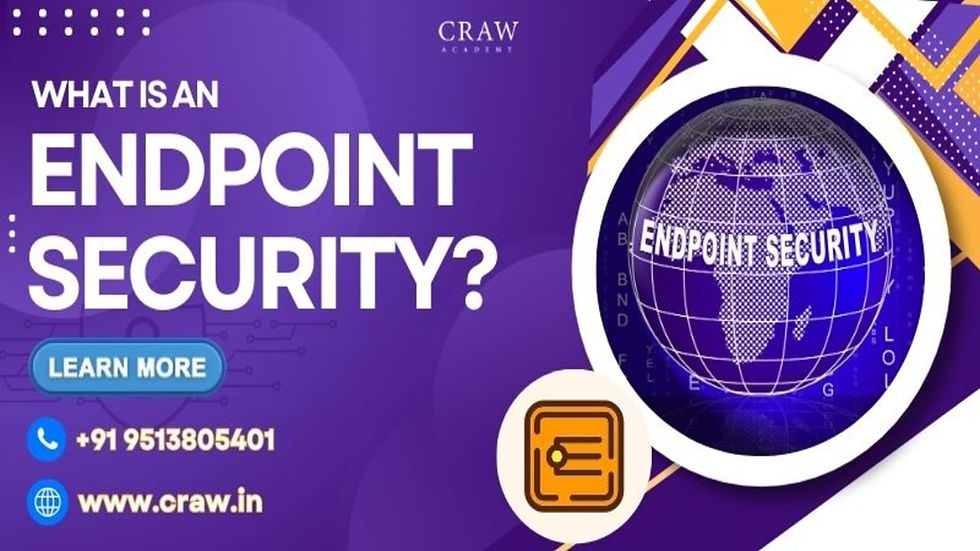What is an Endpoint Security?
- crawsecsaket
- Sep 25
- 4 min read

Understanding Endpoint Security
An endpoint is any device that connects to a network, such as desktops, laptops, smartphones, servers, or IoT devices. Each endpoint acts as a potential entry point for hackers. Think of them as the “front doors” of your digital environment—every door must be secured to prevent unauthorized access.
With the rise of IoT and remote work, the number of endpoints has increased dramatically. In 2018, there were 22 billion connected devices, a figure expected to reach 38.6 billion by 2025 and 50 billion by 2030 (Strategy Analytics). This rapid growth has made endpoint security more critical than ever. According to Verizon’s threat assessment, malware is deployed on endpoints in up to 30% of data breaches.
Example: In 2017, attackers hacked a casino’s IoT fish tank thermostat, using it to access sensitive financial records. This shows how even unusual devices can expand the attack surface.
Common Endpoint Devices
Any computing system linked to an organization’s network qualifies as an endpoint. Examples include:
Tablets: e.g., iPads accessing CRM tools.
Mobile Phones: corporate smartphones with Outlook.
Smartwatches: wearables syncing health data to cloud services.
Printers: networked printers with weak credentials.
Servers: on-premises or cloud servers like AWS EC2.
ATMs: still running outdated systems like Windows XP.
Medical Devices: MRI scanners or insulin pumps connected to hospital networks.
How Endpoint Security Works
Endpoint security solutions are software-based systems that safeguard devices while enforcing compliance. They typically include:
A VPN client for secure connections.
An operating system configured with security controls.
Antivirus and EDR software are updated regularly.
Administrators can monitor, restrict, and quarantine non-compliant devices. The system usually operates on a client-server model, with central management ensuring uniform protection.
Key Security Mechanisms
Access Control: Restricts actions, such as blocking social media on work laptops.
Threat Detection: Uses antivirus (e.g., Bitdefender) and EDR (e.g., CrowdStrike).
Encryption: Protects sensitive data with AES-256 encryption.
VPNs: Secure remote access for remote employees.
Policy Enforcement: Ensures devices follow security standards and updates.
Types of Endpoint Security
IoT Security: Protects connected devices. Example: The 2016 Mirai botnet attack turned IoT cameras into a DDoS army.
Data Loss Prevention (DLP): Detects and prevents data leaks. Example: The 2019 Capital One breach exposed 100M records due to weak DLP, costing $150M.
Network Access Control (NAC): Limits network access to authorized devices.
URL Filtering: Blocks harmful or inappropriate websites. Example: In 2022, Zscaler stopped a phishing campaign using URL filtering.
Browser Isolation: Keeps browsing activities separate to prevent infections. Example: Menlo Security neutralized a malvertising attack in 2023.
Rising Cyber Threats
Cyberattacks are growing in scale and sophistication. Ransomware alone rose by 37% in 2023 (SonicWall). Example: The 2021 Kaseya ransomware attack exploited endpoints, affecting 1,500 companies.
Protecting Sensitive Data
Endpoints often store or access confidential data. With strong encryption and DLP, organizations ensure compliance with regulations such as GDPR and HIPAA. Example: A 2022 T-Mobile breach leaked 37 million records, costing $ 350 million.
Reducing Insider Threats
Verizon’s 2023 DBIR reported that 30% of breaches involve insiders, whether due to negligence or malicious intent.
Maintaining Productivity
When endpoints are secure, employees face fewer disruptions and can work more efficiently, reducing costly downtime.
Key Threats to Endpoints
Phishing: Attackers trick users into sharing sensitive details via email, text, or messages.
Malvertising: Malware hidden in digital ads infects systems when users click on them.
Ransomware: Attackers lock and encrypt data, demanding payment for access.
Benefits of Endpoint Security
Improved Threat Protection: Defends against malware, ransomware, and phishing.
Compliance Support: Helps meet GDPR, HIPAA, and other standards.
Data Protection: Prevents leaks and ensures safe handling of sensitive files.
Centralized Management: Provides uniform oversight across all devices.
Cost Efficiency: Avoids multimillion-dollar losses caused by breaches.
Reduced Insider Risk: Mitigates threats from employees or contractors.
Conclusion
Endpoint security is vital for protecting connected devices like laptops, smartphones, servers, tablets, and IoT equipment. As organizations increasingly depend on digital infrastructures and remote work, the risks associated with unsecured endpoints continue to grow.
By implementing robust solutions—such as VPNs, intrusion detection systems, endpoint monitoring, and encryption—businesses can reduce risks from phishing, ransomware, and insider threats. Beyond strengthening defenses, effective endpoint security ensures compliance, continuity, and long-term resilience in today’s evolving cyber landscape.
FAQs on Endpoint Security
What is an endpoint in cybersecurity?
An endpoint is any device connected to a network, such as desktops, laptops, smartphones, servers, or IoT devices. They act as potential entry points for hackers.
Why is endpoint security important?
Endpoint security protects devices from cyber threats, ensuring that malicious attacks like malware or ransomware don't compromise the organization's network.
What types of devices are considered endpoints?
Endpoints include smartphones, tablets, laptops, printers, servers, ATMs, medical devices, and even IoT devices.
How does endpoint security work?
Endpoint security uses software solutions like VPNs, antivirus software, and encryption to protect devices. It also enforces compliance and monitors device activity to detect and respond to threats.
What is the difference between endpoint security and antivirus?
Endpoint security covers multiple devices, includes advanced features like data loss prevention and encryption, while antivirus focuses on individual devices and basic malware protection.
What are some common endpoint threats?
Common threats include phishing, malvertising (malware in ads), ransomware, and insider threats.
How does endpoint security protect against ransomware?
Endpoint security uses detection, encryption, and access controls to prevent ransomware attacks from encrypting or locking data, and it can block malicious files from executing.
What is Data Loss Prevention (DLP) in endpoint security?
DLP prevents the unauthorized transfer or leak of sensitive data by monitoring and controlling data usage across endpoints.
What is URL filtering in endpoint security?
URL filtering blocks access to harmful or suspicious websites, helping to prevent phishing attacks and malware downloads.
How can endpoint security support compliance with regulations?
Endpoint security helps meet compliance requirements like GDPR and HIPAA by securing sensitive data, ensuring proper access controls, and preventing data breaches.



Comments